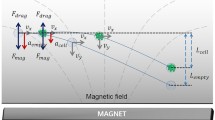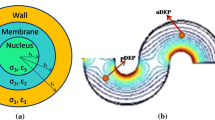Abstract
Microscale bioparticle analysis has advanced significantly providing advantages over bench-scale studies such as the use of a reduced amount of sample and reagents, higher sensitivity, faster response, and portability. Insulator-based dielectrophoresis (iDEP) is a microscale technique where particles are driven by polarization effects under a non-uniform electrical field created by the inclusion of insulators between two electrodes. iDEP possesses attractive advantages over traditional electrode-based dielectrophoresis since there is no electrode degradation and manufacture of the device is simpler and economical. This novel and powerful technique has been applied successfully in the manipulation of macromolecules and cells. In this study, differences in dielectric properties (cell membrane conductivity) of viable and non-viable microalgae, Selenastrum capricornutum, were employed to concentrate and separate a mixture of live and dead cells. A microchannel, manufactured in glass and containing an array of cylindrical insulating posts, was employed to dielectrophoretically immobilize and concentrate the mixture of cells employing direct current electric fields. Experiments showed that live cells exhibited a stronger dielectrophoretic response than dead cells, which allowed cell differentiation. Separation and enrichment of viable and non-viable microalgae was achieved in 35 s with a concentration yield of 10.36 and 15.87 times the initial cell concentration, respectively. These results demonstrate the use of iDEP as a technique for rapid assessment of microalgae viability; unveiling the potential of this powerful technique for environmental applications on lab-on-a-chip platforms.




Similar content being viewed by others
References
Andersen RA (2005) Algal culturing techniques. Elsevier Academic Press, San Diego
Barrett LM, Skulan AJ, Singh AK, Cummings EB, Fiechtner GJ (2005) Dielectrophoretic manipulation of particles and cells using insulating ridges in faceted prism microchannels. Anal Chem 77:6798–6804
Bradford JA, Buller GM (2010) Dead cell stains in flow cytometry. A comprehensive Analysis, Scientific poster, Molecular Probes-Invitrogen Detection Technologies. http://www.invitrogen.com/etc/medialib/en/filelibrary/cell_tissue_analysis/pdfs.Par.48458.File.dat/P317%20Viability%20Dye%20Poster.pdf. Accessed December 2010
Capasso JM, Cossío BR, Berl T, Rivard CJ, Jiménez C (2003) A colorimetric assay for determination of cell viability in algal cultures. Biolmol Eng 20:133–138
Chen KP, Pacheco JR, Hayes MA, Staton SJR (2009) Insulator-based dielectrophoretic separation of small particles in a sawtooth channel. Electrophoresis 30:1441–1448
Cheng BCH (2000) Miniaturizing power supply system for portable computers by improving heat dissipation therein. United States Patent 6081425, United States, 2000
Cho Y-K, Kim S, Lee K, Park C, Lee J-G, Ko C (2009) Bacteria concentration using a membrane type insulator-based dielectrophoresis in a plastic chip. Electrophoresis 30:3153–3159
Cummings EB (2003) Streaming dielectrophoresis for continuous-flow microfluidic devices. IEEE Eng Med Biol Mag 22:75–84
Cummings EB, Singh AK (2003) Dielectrophoresis in microchips containing arrays of insulating posts: theoretical and experimental results. Anal Chem 75:4724–4731
Davalos RV, McGraw GJ, Wallow TI, Morales AM, Krafcik KL, Cummings EB, Simmons BA (2008) Performance impact of dynamic surface coatings on polymeric insulator-based dielectrophoretic particle separators. Anal Bioanal Chem 390:847–855
Du J-R, Juang Y-J, Wu J-T, Wei H-H (2008) Long-range and superfast trapping of DNA molecules in an ac electrokinetic funnel. Biomicrofluidics 2:044103
Garrett DC (2004) Effects of methanol, atrazine, and copper on the ultrastructure of Pseudokirchneriella subcapitata (Selenastrum capricornutum). PhD Dissertation, University of North Texas, Denton
Gascoyne PRC, Vykoukal J (2002) Particle separation by dielectrophoresis. Electrophoresis 23:1973–1983
Gascoyne P, Mahidol C, Ruchirawat M, Satayavivad J, Watcharasit P, Becker FF (2002) Microsample preparation by dielectrophoresis: isolation of malaria. Lab Chip 2:70–75
Graham LE, Wilcox LW (2000) Algae. Prentice-Hall, Upper Saddle River, NJ
Hoagland RW (1999) Switchmode power supply miniaturization with emphasis on integrated passive components on prefired high performance ceramic substrates. PhD Dissertation, Virginia Polytechnic Institute and State University, Blacksburg
Hubner Y, Hoettges KF, Hughes MP (2003) Water quality test based on dielectrophoretic measurements of fresh water algae Selenastrum capricornutum. J Environ Monit 5:861–864
Kang Y, Li D, Kalams S, Eid J (2008) DC-Dielectrophoretic separation of biological cells by size. Biomed Microdev 10:243–249
Kang Y, Cetin B, Wu Z, Li D (2009) Continuous particle separation with localized AC-dielectrophoresis using embedded electrodes and an insulating hurdle. Electrochim Acta 54:1715–1720
Lapizco-Encinas BH, Rito-Palomares M (2007) Dielectrophoresis for the manipulation of nanobioparticles. Electrophoresis 28:4521–4538
Lapizco-Encinas BH, Simmons BA, Cummings EB, Fintschenko Y (2004a) Dielectrophoretic concentration and separation of live and dead bacteria in an array of insulators. Anal Chem 76:1571–1579
Lapizco-Encinas BH, Simmons BA, Cummings EB, Fintschenko Y (2004b) Insulator-based dielectrophoresis for the selective concentration and separation of live bacteria in water. Electrophoresis 25:1695–1704
Lapizco-Encinas BH, Davalos R, Simmons BA, Cummings EB, Fintschenko Y (2005) An insulator-based (electrodeless) dielectrophoretic concentrator for microbes in water. J Microbiol Methods 62:317–326
Li H, Bashir R (2002) Dielectrophoretic separation and manipulation of live and heat-treated cells of Listeria on microfabricated devices with interdigitated electrodes. Sens Actuator B Chem 86:215–221
Li L, Song L (2007) Applicability of the MTT assay for measuring viability of cyanobacteria and algae, specifically for Microcystis aeruginosa (Chroococcales, Cyanobacteria). Phycologia 46:593–599
Markelova AG, Vladimirova MG, Kuptsova ES (2000) A comparison of cytochemical methods for the rapid evaluation of microalgal viability. Russ J Plant Physiol 47:815–819
Markx GH, Huang Y, Zhou XF, Pethig R (1994) Dielectrophoretic characterization and separation of microorganisms. Microbiology-UK 140:585–591
Medoro G, Manaresi N, Altomare L, Leonardi A, Tartagni M, Guerrieri R (2002) In: Proceedings of the 16th European conference on solid-state transducers (Eurosensors XVI), vol 1, pp 47–51, Prague, Czech Republic, September, 2002
Moncada-Hernández H, Lapizco-Encinas BH (2010) Simultaneous concentration and separation of microorganisms: insulator-based dielectrophoretic approach. Anal Bioanal Chem 396:1805–1816
Mukhopadhyay P, Rajesh M, Batkai S, Kashiwaya Y, Hasko G, Liaudet L, Szabo C, Pacher P (2009) Role of superoxide, nitric oxide, and peroxynitrite in doxorubicin-induced cell death in vivo and in vitro. Am J Physiol Heart Circ Physiol 296:H1466–H1483
Pethig R, Markx GH (1997) Applications of dielectrophoresis in biotechnology. Trends Biotechnol 15:426–432
Pohl HA (1951) The motion and precipitation of suspensoids in divergent electric fields. J Appl Phys 22:869–871
Pohl HA (1978) Dielectrophoresis. Cambridge University Press, Cambridge
Pohl HA, Kaler K (1979) Continuous dielectrophoretic separation of cell mixtures. Cell Biochem Biophys 1:15–28
Pouneva I (1997) Evaluation of algal culture viability and physiological state by fluorescent microscopic methods. Bulg J Plant Physiol 23:67–76
Pysher MD, Hayes MA (2007) Electrophoretic and dielectrophoretic field gradient technique for separating bioparticles. Anal Chem 79:4552–4557
Raja R, Hemaiswarya S, Kumar NA, Sridhar S, Rengasamy R (2008) A perspective on the biotechnological potential of microalgae. Crit Rev Microbiol 34:77–88
Rousselet J, Markx GH, Pethig R (1998) Separation of erythrocytes and latex beads by dielectrophoretic levitation and hyperlayer field-flow fractionation. Colloid Surf A Physicochem Eng Asp 140:209–216
Sabounchi P, Huber DE, Kanouff MP, Harris AE, Simmons BA (2008) In: Proceedings of the 12th international conference on miniaturized systems for chemistry and life sciences (MicroTAS 2008), vol 1, pp 50–52, San Diego CA, 12–16 October 2008
Sabounchi P, Morales AM, Ponce P, Lee LP, Simmons BA, Davalos R (2008b) Sample concentration and impedance detection on a microfluidic polymer chip. Biomed Microdev 10:661–670
Sato M, Murata Y, Mizusawa M, Iwahashi H, Oka S (2004) A simple and rapid dual-fluorescence viability assay for microalgae. Microbiol Cult Coll 20:53–59
Schork MA, Remington RD (2000) Statistics with applications to the biological and health sciences. Prentice Hall, Upper Saddle River, NJ
Simmons BA, McGraw GJ, Davalos RV, Fiechtner GJ, Fintschenko Y, Cummings EB (2006) The development of polymeric devices as dielectrophoretic separators and concentrators. MRS Bull 31:120–124
Suehiro J, Hamada R, Noutomi D, Shutou M, Hara M (2003a) Selective detection of viable bacteria using dielectrophoretic impedance measurement method. J Electrostat 57:157–168
Suehiro J, Zhou GB, Imamura M, Hara M (2003b) Dielectrophoretic filter for separation and recovery of biological cells in water. IEEE Trans Ind Appl 39:1514–1521
Urdaneta M, Smela E (2007) Multiple frequency dielectrophoresis. Electrophoresis 28:3145–3155
USEPA (1996) Ecological effects test guidelines: OPPTS 850.5400 Algal toxicity, tiers I and II. United States Environmental Protection Agency document EPA712-C-96-164, Office of Prevention, Pesticides and Toxic Substances, Washington, D.C
Voldman J (2006) Electrical forces for microscale cell manipulation. Ann Rev Biomed Eng 8:425–454
Wanichapichart P, Bunthawin S, Kaewpaiboon A, Kanchanapoom K (2002) Determination of cell dielectric properties using dielectrophoretic technique. ScienceAsia 28:113–119. http://www.scienceasia.org/
Washizu M, Kurosawa O (1990) Electrostatic manipulation of DNA in microfabricated structures. IEEE Trans Ind Appl 26:1165–1172
Whitesides GM (2006) The origins and the future of microfluidics. Nature 442:368–373
Wu Y, Huang C, Wang L, Miao X, Xing W, Cheng J (2005) Electrokinetic system to determine differences of electrorotation and traveling-wave electrophoresis between autotrophic and heterotrophic algal cells. Colloid Surf A Physicochem Eng Asp 262:57–64
Acknowledgments
The authors would like to acknowledge the financial support provided by grant CONACYT-CB-2006-53603. The authors are grateful for the financial support provided by Dr. Mario M. Álvarez and Cátedras de Investigación (CAT122 and CAT142) of Tecnológico de Monterrey and support provided by CINVESTAV-Monterrey.
Author information
Authors and Affiliations
Corresponding author
Electronic supplementary material
Below is the link to the electronic supplementary material.
Supplementary material 1 (AVI 10615 kb)
Rights and permissions
About this article
Cite this article
Gallo-Villanueva, R.C., Jesús-Pérez, N.M., Martínez-López, J.I. et al. Assessment of microalgae viability employing insulator-based dielectrophoresis. Microfluid Nanofluid 10, 1305–1315 (2011). https://doi.org/10.1007/s10404-010-0764-3
Received:
Accepted:
Published:
Issue Date:
DOI: https://doi.org/10.1007/s10404-010-0764-3




